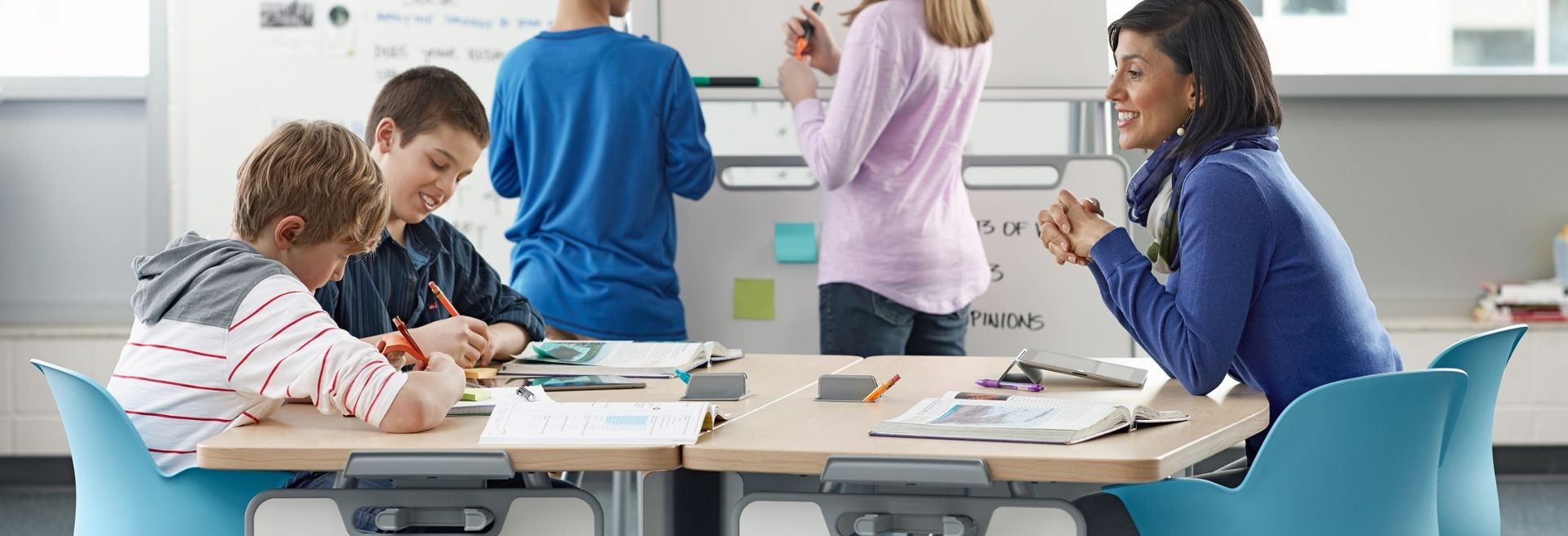Promoting Mental Health & Wellbeing in Educational Spaces
Students in every age group, from kindergarten to higher education classrooms, are more burdened with psychological stressors than ever before. Prior to the COVID-19 pandemic, instances of anxiety and depression were already on the rise. The global catastrophe only exacerbated these trends by increasing social isolation, disrupting routines and diminishing the effectiveness of learning1.
With roughly half of mental health conditions becoming apparent by the age of 14, and 75 percent evincing by age 242, educational designers have the opportunity to enact systemic, environmental change that directly impacts student wellbeing. Aileen Strickland, a senior design researcher at Steelcase, suggests a broad definition of wellbeing that extends beyond emotions to include an interconnected set of physical, cognitive and emotional factors. Here, we look at a few of the ways in which interior design can enhance holistic wellness and improve the educational experience.
Flexible Designs for Multiple Learning Styles
The concept of flexibility continues to dominate conversations across market verticals, and education is no different. For non-neurotypical students, traditional classroom environments can become sites of anxiety and distress. Many wilt in the rigid, front-facing floorplans typified by what Paulo Freire called the banking model of education, which relied on the central metaphor of students as containers into which educators deposit knowledge.
As pedagogy has, broadly speaking, moved away from the banking model toward more student-driven learning, interior designers have begun building flexibility into the physical layout of classrooms. Moveable furniture and technology give students more control over their learning environments, allowing them to easily shift between different modalities and tasks. The ability to manipulate one’s own environment can reduce stress and anxiety while boosting feelings of self-worth and belonging. Indeed, it’s much easier to recognize the value of cognitive and psychological diversity when the classroom itself embraces difference.
Steelcase’s chevron-shaped Verb tables offer a prime example of flexibility in action. These rolling workstations can be arranged into front-facing semi-circles, small-group collaboration zones or used as personal desks.
Nature-Infused Wellbeing Boosters
Ample research has demonstrated the value of incorporating biophilic design elements into educational spaces. One meta-analysis found that biophilic design reduced stressed, improved student perceptions of the learning environment and even boosted test scores3. There are a number of ways in which you can add natural elements into the classroom.
Biomorphic forms and fractal patterns — i.e. visual representations of patterns that appear in nature, such as the veins of a leaf or dimples in sand — can be incorporated into furniture, textiles, wallcoverings, flooring and even baffling. Moduform, for example, offers several bedroom sets for healthcare spaces, such as the Zeal Collection, that feature wood grain in a variety of soothing tones.
Dynamic window coverings can also boost wellbeing while facilitating multiple activities in the classrooms. Shades often need to be lowered, for example, to darken the room when videos are shown. Instead of opaque blackout shades, opt for material that admits diffuse light to increase visual comfort while supporting healthy circadian rhythms. Even views of nature beyond the classroom can positively affect student wellbeing and mental health. The movement of plants, birds and insects tends to draw students’ attention outside temporarily, which can have a restorative effect on the brain.
Dedicated Spaces for Mindfulness and Rest
The design elements we’ve discussed so far are considered embedded, meaning they’re incorporated organically into shared learning spaces. Dedicated spaces, on the other hand, are nooks, rooms or even entire floors specifically designed to promote mental wellness and self-care. Such spaces include mindfulness rooms, private lounges, fitness centers and counseling offices. These wellness zones give students the opportunity to find rest in the midst of their busy days, center their minds and care for their bodies.
Just as importantly, intentionally constructing and designing these spaces sends the message that wellness-enhancing activities are not only allowed, but encouraged. Thoughtful design can thereby support children, adolescents and young adults as they engage in the difficult work of identity formation and development.
To create dedicated spaces, consider incorporating products that encourage relaxed postures, individual ideation and quiet reflection. Brody Lounge Chairs by Steelcase, for example, create havens even in large rooms, allowing students to work or rest in a sheltered space.
Interested in learning more about how you can prioritize wellness and mental health in educational interior design? McCoy Rockford is here to help! Contact us to schedule a showroom tour today.
Sources

